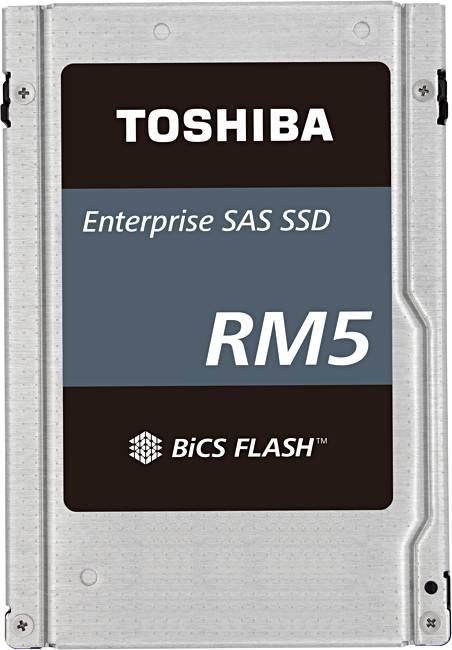This article is more than 1 year old
Who dares wins, they say, so Toshiba's SAS drive plans another hit on SATA
Faster interface aims to replace 6Gbit/s dead end in servers
Toshiba has sent in a SAS SSD hit team to assault SATA SSDs and their slower interface in the shape of its RM5 vSAS drive.
It has priced the drive at SATA levels, referring to it as a vSAS drive, where "v" is for value. OK. SATA interface speeds of 6Gbit/s are not good enough for servers, and cheaper SAS should, Toshiba said, take over.
Capacity, using TLC (3bits/cel) 3D NAND, starts at 960GB and goes through 1.92 and 3.94TB on the way to 7.68TB. The endurance is one drive write per day for five years, and it has a 2.5 million hours mean time between failures rating. The read/write latency is 140/60μs.
The interface is 12Gbit/s SAS, with a single port, and it is intended for server use.

Toshiba has said SATA drives often use SAS expanders to scale out, while the RM5 enables use of end-to-end native SAS.
Below the RM5's performance parameters are compared with recent Samsung and Micron 6Gbit/s SATA drives of similar capacity, counting random read/write IOPS and sequential read/write MB/sec bandwidth:
| Random Read | Random Write | Sequential read | Sequential Write | |
|---|---|---|---|---|
| Tosh RM5 | 150,000 | 35,000 | 838 | 650 |
| Micron 5200 Pro | 95,000 | 33,000 | 540 | 520 |
| Samsung 860 Pro | 100,000 | 90,000 | 560 | 530 |
All numbers are "up to" values. The 860 Pro goes up to 4TB capacity while Micron's 5200 Eco goes up to 7.68TB.
Toshiba's RM5 outperforms them, except on random writes where Samsung's 860 Pro is much better.
Of course we could step back and view the RM5 as just another SAS server SSD, in which case it's slow. Here's a comparison with Samsung's PM1643 and HGST's Ultrastar SS300:
| Random Read | Random Write | Sequential read | Sequential Write | |
|---|---|---|---|---|
| Tosh RM5 | 150,000 | 35,000 | 838 | 650 |
| Samsung PM1643 | 400,000 | 50,000 | 2,100 | 1,700 |
| HGST Ultrastar SS300 | 400,000 | 120,000 | 2,100 | 1,250 |
The RM5 sucks at this level.
Toshiba hopes SATA will give way to SAS in server 2.5-inch SSDs while expecting performance SAS SSDs to give way to NVMe. It could grow sales by converting SAS SSDs to SAS ones until, eventually, NVMe takes over from SAS as well.
Jeremy Werner, VP marketing and product planning for Toshiba Memory America, said: "Servers that use SATA currently represent the majority of the market, and our RM5 series is designed to replace SATA SSDs. This is important, as the roadmap for SATA ends with the current 6Gbit/s generation."
Toshiba hasn't yet provided a release date or pricing for the RM5. ®
